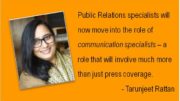Two high-stress, interdependent professions – the relationship between PR professionals and journalists has long been a topic of discussion. Often, this relationship is mildly strained, becoming a “can’t live with them, can’t live without them” situation. The general perception of professionals from both fields about each other is not always favourable. According to a 2016 study conducted in Croatia by Vercic and Colic, it was found that most individuals from both sides of the fence do not feel that ethical and moral standards of the other side are up to the mark. This sort of perception arises largely due to the pressure on PR professionals to gain visibility for a brand or an individual, consequently leading to pitches that are not necessarily relevant to a certain publication, or are just not newsworthy. This in turn makes it difficult for journalists to have faith in the credibility and context of many PR pitches.
However, this relationship doesn’t have to be strained. There is potential for it to develop into a seamless symbiosis, because ultimately these two professions are intimately connected, and with cooperation will only flourish! Certain things do need to change, though – so here are some ways PR professionals can make the most of the media world in a healthy, productive manner.
No More Generic Mass Emails
It may seem like the most efficient thing to do, but sending out a generic pitch to your entire journalist contact list is actually counter-productive. Journalists want stories to publish. They are looking for newsworthy content, for stories with depth and context. When they receive a generic pitch which may not suit their requirements or the realm that their publication belongs in, they will not only reject it, but will probably be reluctant to take you seriously in the future. While it is true that the more people you reach out to, the higher your chances are of striking gold, the focus should not be just on quantity. Figure out what story you are telling and who will want to read it and then you will know which journalists and media platforms to approach where your content will be relevant and sought after. Look at different aspects of the brand or organisation you are dealing with. Each aspect will appeal to a certain section of the audience, and therefore will make sense in certain media outlet. So, even if you do want to get in touch with a large number of journalists, group them according to their areas of interest and use a targeted approach while pitching.
How Newsworthy is it?
Remember that not everything your client or you think is of value, is actually newsworthy enough for mass reach and appeal. Journalists look for stories that are worth telling and that people in general want to hear. If your news is significant for only a small group of 50-100 people, it is likely that a journalist will be hesitant in publishing it. If, however, it is currently relevant only to a small group, but has the potential to create awareness and become significant to the larger audience, then it can be worthy of consideration. According to PR expert, Christopher Van Mossevelde, this checklist could help you screen your stories before deciding whether or not to pitch them to a journalist:
- Timing – is it current?
- Proximity – does it feel relatable or close to home?
- Significance – is it relevant to the audience?
- Prominence – is it of widespread interest or importance?
- Human interest– is it inspiring or does it stand out? Does it have an emotional angle?
If it feels like a forced pitch to you, and it doesn’t tick any of the above points, then you know it’s not worth telling.
Keep Calm with Integrity
One reason behind the strained relationship between journalists and PR professionals is that journalists often feel they are being misled. Yes, PR is about getting the good word out, but that does not mean compromising on basic ethics. If a story has an angle to it that you need to hide from the journalist, or if you find yourself glossing over certain facts or excluding some relevant and important data, then you know you are misleading not just the journalist but also the wider audience. You may feel compelled to do this, but consider that this story may not be one that needs to be told. Another reason such glitches may arise with a story is if you as a PR professional do not do your homework. All facts, figures, data, information and insights need to be verified by you, and if possible even by a third party for concrete credibility. No one is going to reject a relevant, well-researched, credible story pitch. Certain things can even be discussed with the journalist. Everyone’s opinion and angle should be valued. While not all journalists are okay with being approached in this manner, many might be open to helping PR professionals better understand what is needed and how they can help.
Go a Step Further
While sticking to the give-and-take of a pitch is what most PR professionals do, going beyond this to help journalists in other small ways, can be a big clincher and can help build a strong base to the relationship. One way to do this is to read and distribute their work. Not only does this instil a sense of mutual support, this is also good homework for you. In a competitive field like journalism, showing your support can help someone be heard, and can also give you a chance to be heard in the future. Another aid at the disposal of PR professionals is their resources. You could help out if you know a thought leader in a field that the journalist is writing on, or a connection that would be helpful to them. After all, in “give-and-take”, “give” comes first.
When you have a brand’s best interests at heart, and exhaustive homework and honesty to back you, your relationship with journalists won’t even feel like something that needs to be “managed”. It will develop organically into a mutually-beneficial system where stories that are worth telling, will most definitely be heard.








Be the first to comment on "Can we really manage media?"